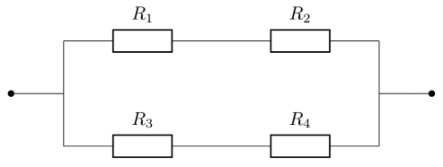Task 3: Equivalent Resistance
Task
Write a program resistance.cpp that computes the equivalent resistance of the following wiring:
We assume that \(R_1\), \(R_2\), \(R_3\), and \(R_4\) have an integer valued resistance. After input of the four values, the program should output the result arithmetically rounded to the nearest integer.
Remark: In order to facilitate the task, you may want to:
- Conceptually divide the task into sub tasks. For example, start with computation of serial resistors \(R_{12}\) and \(R_{34}\).
- Solve the task first naively using default rounding and then think about how to accomplish arithmetic rounding. Recall that \(\text{round}(x) = [x + 0.5] \text{ }\forall \text{ } x \in \mathbb{R}\), i.e., a real number can be rounded arithmetically by adding \(0.5\) to it and then rounding down. For example, \(\text{round}(8,6) = [8.6 + 0.5] = [9.1] = 9\).
You can find formulas for computing the total resistance in this Wikipedia article.
Important: using anything other than int (e.g., floating point numbers, long, or double long) is forbidden.
Important: using if-else and any other branches is forbidden.
Solution
#include <iostream>
int main() {
int r1;
int r2;
int r3;
int r4;
int res;
std::cin >> r1;
std::cin >> r2;
std::cin >> r3;
std::cin >> r4;
int r12 = r1 + r2;
int r34 = r3 + r4;
res = (r12 * r34 + ((r12 + r34) / 2)) /
(r12 + r34); // By adding the average of r12 and r34, the result is
// increased enough to get the correct rounded number
std::cout << res;
return 0;
}-——
Made by JirR02 in Switzerland 🇨🇭
